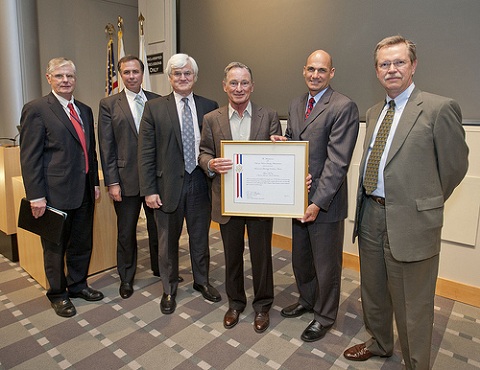ACADEMIA
Livermore’s Michel McCoy honored with first NNSA Science and Technology Award
Michel McCoy, whose pioneering work in supercomputing established Lawrence Livermore as a world renowned supercomputing center, was honored Thursday with the National Nuclear Security Administration’s Science and Technology Award.
McCoy received the award for “16 years of dedicated and relentless pursuit of excellence” from NNSA Administrator Thomas D’Agostino to a standing ovation from colleagues during an early afternoon ceremony in the TSF’s Armadillo Room.
Calling HPC “the lifeblood of NNSA science and technology,” D’Agostino said McCoy’s leadership in HPC “has had a global impact.”
“Mike McCoy is an example of the difference one individual can make on a team,” D’Agostino said. “You have to have a leader who knows how to pull things together and to make tough decisions. That leader is Mike McCoy. If it wasn’t for Mike, this would be a very different place.”
In introducing D’Agostino, Lab Director Parney Albright noted his agreement with WCI Principal Associate Director Bruce Goodwin’s assertion that “HPC is the intellectual electricity of this Laboratory.” Albright called McCoy “the heart and soul of HPC, not just for this Lab but for the NNSA program.”
The newly created Science and Technology Excellence Award is the highest recognition for science and technology achievements in NNSA. The award recognizes accomplishments that can include vision, leadership, innovation and intellectual contributions. McCoy is the first recipient of the award.
As director of LLNL’s Advanced Simulation and Computing (ASC) program, a deputy director for Computation and head of the Integrated Computing and Communications Department, McCoy leads the Laboratory’s effort to develop and deploy the high performance computing systems required for the three national weapons labs to fulfill their mission to ensure the safety, security and reliability of the nation’s nuclear deterrent without testing – systems such as Sequoia.
In addition, McCoy has worked tirelessly to make high performance computing resources available to U.S. industry and the broad spectrum of Laboratory research programs in the belief that the more researchers use HPC, the faster computing technology and applications will develop for the benefit of the country. McCoy created the Multi-programmatic and Institutional Computing (M&IC) program to provide HPC resources to the LLNL scientific disciplines that were suffering from a critical shortage of computing capacity to maintain their strategic capabilities, to build their disciplines, and to retain their workforce. He also leads and provides strategic direction for Livermore Computing (LC), the organization that today supports all aspects of classified and unclassified HPC at LLNL, providing service to more than 2,600 users, and is widely recognized as the world’s premier scientific high performance computing center.
Over 16 years, McCoy has led the procurement and installation of numerous supercomputing systems ranked among the top 10 of the Top500 list of the world’s fastest supercomputers, notably ASCI White, BlueGene/L and Sequoia, all of which held the No. 1 ranking as the world’s fastest machines.
NNSA cited McCoy’s “development of a strategy for simultaneous exploitation of multiple computing technologies to meet a broad spectrum of mission requirements at low cost.” The success of this strategy led to McCoy receiving LLNL’s Edward Teller Prize in 2004.
Acknowledging that he was overwhelmed, McCoy said he accepted the award with a “deep sense of gratitude.”
But in remarks concluding the ceremony, McCoy was quick to credit the support of Lab and NNSA leadership and the members of his staff for the success of the ASC program. He attributed that success to the atmosphere of innovation created at the Lab and the people who thrive in such an environment.
“The atmosphere has to be right for innovation. That’s not something you can manufacture; it has to come from people at the top who encourage innovation,” McCoy said, noting the breadth of disciplines needed for HPC. “Teamwork is what has made us successful. This is one team. That’s a part of the magic of this place.
Like any great athlete, we can only stay at the top of our game if we are continuously challenged” he concluded. “We’re ready for future challenges and the harder the better. We won’t let you down.”

